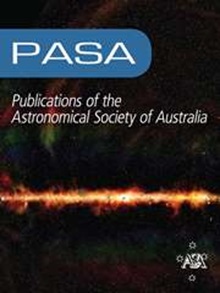Evolution of the magnetic field and flows of solar active regions with persistent magnetic bipoles before emergence
IF 4.6
3区 物理与天体物理
Q1 ASTRONOMY & ASTROPHYSICS
Publications of the Astronomical Society of Australia
Pub Date : 2023-12-06
DOI:10.1017/pasa.2023.52
引用次数: 0
Abstract
Magnetic active regions on the Sun are harbingers of space weather. Understanding the physics of how they form and evolve will improve space weather forecasting. Our aim is to characterise the surface magnetic field and flows for a sample of active regions with persistent magnetic bipoles prior to emergence. We identified 42 emerging active regions (EARs), in the Solar Dynamics Observatory Helioseismic Emerging Active Region survey (Schunker et al. 2016, A&A. 595, A107), associated with small magnetic bipoles at least one day before the time of emergence. We then identified a contrasting sample of 42 EARs that emerge more abruptly without bipoles before emergence. We computed the supergranulation-scale surface flows using helioseismic holography. We averaged the flow maps and magnetic field maps over all active regions in each sample at each time interval from 2 d before emergence to 1 d after. We found that EARs associated with a persistent pre-emergence bipole evolve to be, on average, lower flux active regions than EARs that emerge more abruptly. Further, we found that the EARs that emerge more abruptly do so with a diverging flow of出现前具有持续磁双极的太阳活动区的磁场演化和流动
太阳上的磁活跃区是太空天气的先兆。了解它们形成和演化的物理原理将改善太空天气预报。我们的目的是表征表面磁场和流动的一个样本的活跃区域与持久的磁双极出现之前。在太阳动力学观测站日震新兴活动区调查(Schunker et al. 2016, A&A)中,我们确定了42个新兴活动区(ear)。595, A107),至少在出现前一天与小磁极有关。然后,我们确定了42个ear的对比样本,它们在出现之前没有双极,出现得更突然。我们用日震全息术计算了超颗粒尺度的地表流动。我们将每个样品在出生前2天至出生前1天的每个时间间隔内所有活动区域的流图和磁场图取平均值。我们发现,与持续出现前的双极相关的耳朵,平均而言,比突然出现的耳朵更低的通量活跃区域。此外,我们发现更突然出现的ear的发散流为$(3\pm 0.6) \乘以10^{-6}$ s $^{-1}$,大约为50-100 ms $^{-1}$。我们的结果表明,在整个涌现过程中,表面流动特征与活动区的最大磁通量存在统计依赖性。
本文章由计算机程序翻译,如有差异,请以英文原文为准。
求助全文
约1分钟内获得全文
求助全文
来源期刊
CiteScore
5.90
自引率
9.50%
发文量
41
审稿时长
>12 weeks
期刊介绍:
Publications of the Astronomical Society of Australia (PASA) publishes new and significant research in astronomy and astrophysics. PASA covers a wide range of topics within astronomy, including multi-wavelength observations, theoretical modelling, computational astronomy and visualisation. PASA also maintains its heritage of publishing results on southern hemisphere astronomy and on astronomy with Australian facilities.
PASA publishes research papers, review papers and special series on topical issues, making use of expert international reviewers and an experienced Editorial Board. As an electronic-only journal, PASA publishes paper by paper, ensuring a rapid publication rate. There are no page charges. PASA''s Editorial Board approve a certain number of papers per year to be published Open Access without a publication fee.

 求助内容:
求助内容: 应助结果提醒方式:
应助结果提醒方式:


